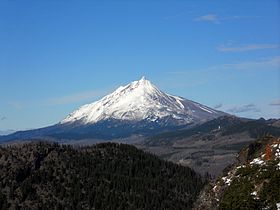Mount Jefferson (Oregon)
| Mount Jefferson | |
|---|---|

Mount Jefferson from the north side of Three Fingered Jack
|
|
| Highest point | |
| Elevation | 10,497 ft (3,199 m) |
| Prominence | 5,777 ft (1,761 m) |
| Listing | |
| Coordinates | 44°40′27″N 121°47′58″W / 44.6743006°N 121.799573611°WCoordinates: 44°40′27″N 121°47′58″W / 44.6743006°N 121.799573611°W |
| Geography | |
| Location | Jefferson, Linn and Marion counties, Oregon, U.S. |
| Parent range | Cascade Range |
| Topo map | USGS Mount Jefferson |
| Geology | |
| Age of rock | Less than 100,000 years |
| Mountain type | Stratovolcano |
| Volcanic arc | Cascade Volcanic Arc |
| Last eruption | About 950 AD |
| Climbing | |
| First ascent | 1888 by R. L. Farmer and E. C. Cross |
| Easiest route | Rock climb |
Mount Jefferson is a stratovolcano in the Cascade Volcanic Arc, part of the Cascade Range, and is the second highest mountain in Oregon. It is situated in the far northeastern corner of Linn County on the Jefferson County line, with the lower reaches extending northward into southeastern Marion County. The mountain, about 105 miles (169 km) east of Corvallis, is federally protected as part of the Mount Jefferson Wilderness. Due to the rugged area, the mountain is one of the hardest volcanoes to reach in the Cascades, though USFS Road 2243 does come within 4 miles (6.4 km) of the summit. Jefferson's craggy and very glacially scarred appearance makes it especially photogenic.
Mount Jefferson (originally called Mount Vancouver by the British) was named in honor of U.S. President Thomas Jefferson by the Lewis and Clark Expedition. The expedition, which was sponsored by President Jefferson, first saw the peak from the mouth of the Willamette River in March 1806. A Native American name for the mountain is Seekseekqua.
The first ascent was probably accomplished by E. C Cross and Ray L. Farmer on 12 August 1888 by way of the south ridge. George J. Pearce, who accompanied Cross and Farmer on the expedition, wrote an account of the climb for the Oregonian newspaper on 22 August 1900. The first climber to reach the summit via the north face was S. S. Mohler in 1903.
One of the most complete studies of the volcano was compiled in a large report written in the 1920s by a former professor of geology at the University of Oregon, Edwin T. Hodge. Probably due to its remoteness there has been little work done on a comprehensive study of the mountain since then. The most notable exception was a 1974 study of the volcano's glacial and volcanic history carried out by Kenneth G. Sutton.
...
Wikipedia

